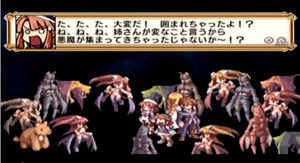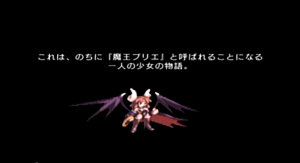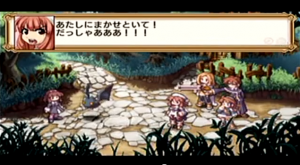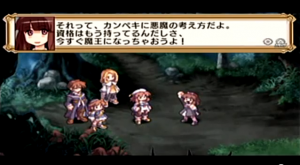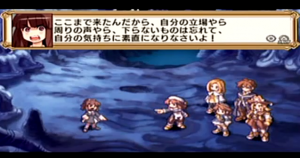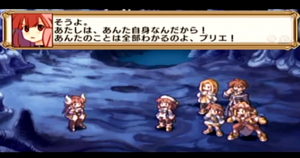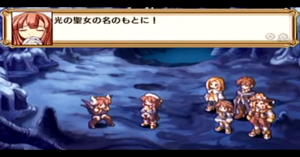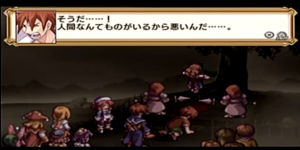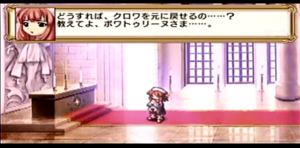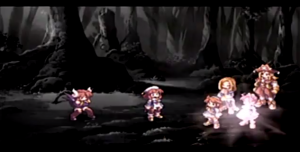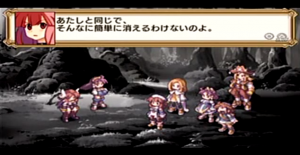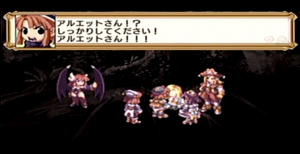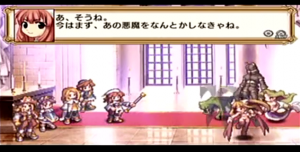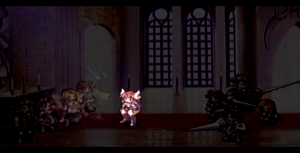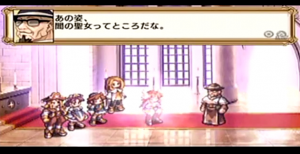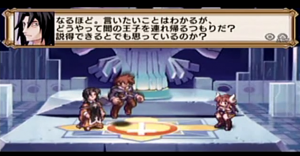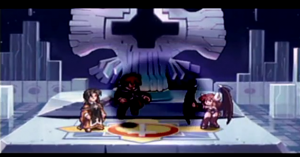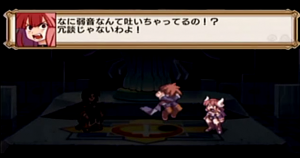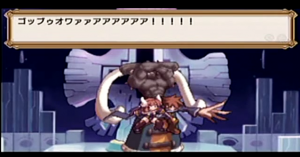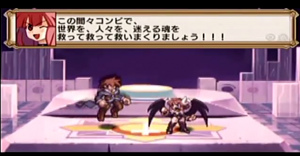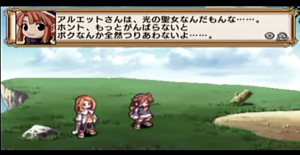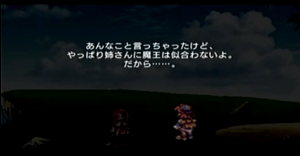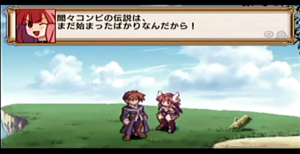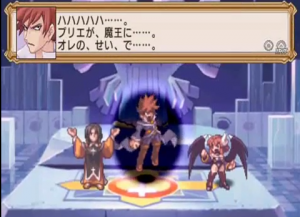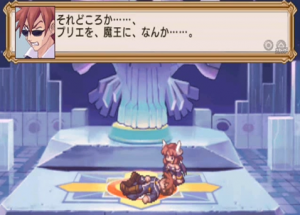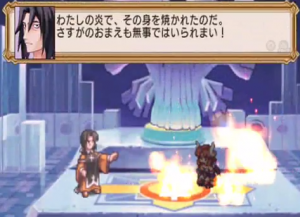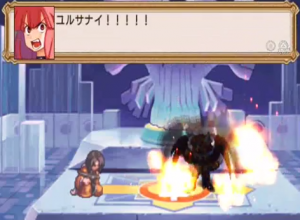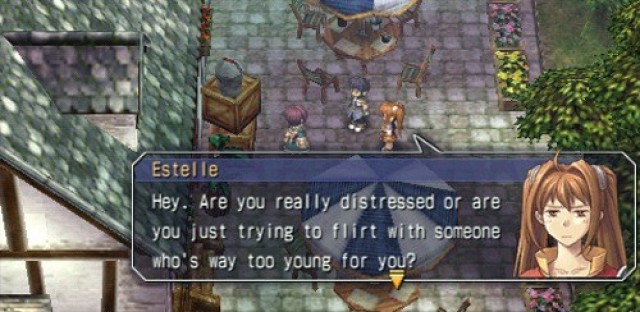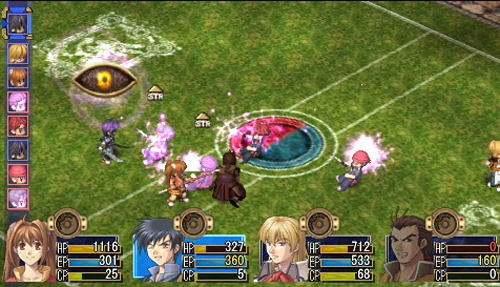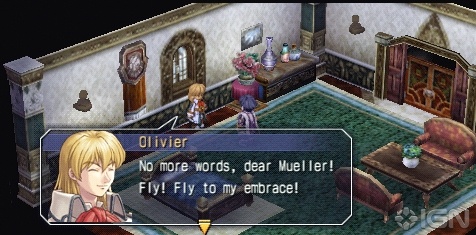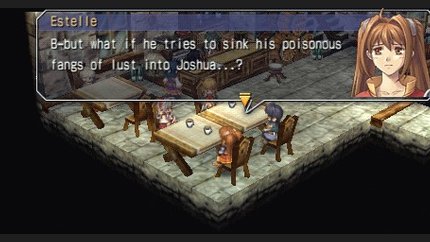But then the desire gets out of control and literally manifests as another Prier, looking like a child version of herself. The other-Prier appears and tells real-Prier that her heart is dark enough to just go ahead and become an Overlord. Prier responds with an adamant “No way, I’m going to become the Maiden of Light!”
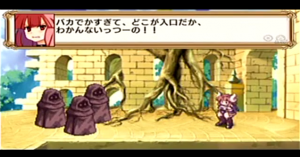
With her new-found power, Prier decides “Well, Noir can’t destroy the world without Croix. And since *I* can be a demon and not go crazy, I’ll go show Croix how to do that.” She states “Leave it to me” and just leaps into the air like superman to go save Croix and then gleefully busts down the door of the demon stronghold with a “Damn, what’s with this stupidly powerful strength? I was just trying to knock.”
Croix begins to say “Whoa, this aura-” but Prier cheerfully interrupts, “Yeah, I’m an Overlord now, no biggie. Just ignore the demonish aura thing~”
Disclaimer: Post contains words you would not take home to mother ranted by some kind of bad man. Read at your own discretion.
The long story short is that we pay near twice as much as the US release for games. It is very slowly becoming better on some platforms some of the time. I trend towards PC games for this reason, we only get gouged about 50% for new releases.
Here is a story of a new sales platform to the market completely and totally fucking this up in the face of an already insulted and downtrodden public who are all too aware of how much we are being spitroasted from both ends for game sales. Especially for digital product where the cost difference in delivery of the product is often dealt to us through the cost of our net connections rather than the producers content servers hosted in the US. (To be fair, plenty of distributors do host servers here in Australia which are notoriously expensive for no good reason. This is a notoriety that grew from the price of server infrastructure when you were relying largely on one ISP to do it well. Now this is no longer the case).
The game being used as example here is a new release. Kingdoms of Amalur: Reckoning, it is supposed to be okay and is written by R.A. Salvatore which for some reason gives some dudes big hard ons. When I want a pulpy fantasy plot sometime I will hold my breath for a game written by Margaret Weiss and/or (preferably and) Tracey Hickman. They trend towards a higher fantasy level of pulp in my opinion. I only really have a passing interest in this game. I was just running across the prices on the front pages as it is fairly new while I looked for something else.
EXHIBIT A
Here we have the games price on Steam. $60US, you know, the price of a new game these days ($40 cheaper than I used to pay for reference). That is all well and good. Steam does a pretty good service and I like it. It has a few downfalls and I don’t look forward to the day Valve curls up and dies (heavens forbid), but for now it gives me access to old stuff I like and new stuff at a generally decent price.
Also note that Steam is fully capable of charging a regional price as determined by the publisher. I could just as easilly be posting links about how Darkness 2 is $90 or Modern Warfare 3 is $100 because why the fuck not? Instead I am going to show you something straight up fucking batshit insane retarded.
EXHIBIT B
This is a screenshot of the cost of Kingdoms of Amalur: Reckoning on Origin at release. A whole $20 more because they have it region encoded on Origin. So yeah I am used to that feeling, it is my colon slightly expanding out as a stranger finds me in the Alps because I live in Australia and I like to play games. It is not really a comfortable feeling, but it is one I am used to baring. You know how it goes in these prison colonies, you fight against it at first and then you just give up and let it happen so you can get on with your day. Even getting abused every day can get mundane. I have things to do and games that I want to play, so I just blow an even larger disproportionate amount of my income on my hobby because that is the price point things have always been and people will pay for it.
The real failure here is that this completely pulls the rug out from under EAs attempts to make Origin a reasonable alternative to platform to Steam. I only use it because I absolutely have to. They aren’y empowering me as a consumer, they are just forcing me to have one more process that I need to shut down after I finish using it to play the one EA game I feel like playing this quarter (bonus points for Old Republic not needing Origin running). I hate to be saying this, but you should have fucked us out of that $20 on Steam if you were even going to hope to get Origin to be taken seriously as an option for this game. Maybe they are contractually obligated to do so to keep the price in brick and mortar stores competetive, but this either means their agreements somehow missed Steam and EA really wanted to sell it at $60 but can’t, or they just don’t even care enough anymore to fuck us over properly.
I am not even sure what is more insulting. The continued abuse or the fact that it is so half hearted these days. What happened to us EA? We used to have a real good hatefuck relationship going on. I ranted about how you published the same piece of shit drivel every year and then you closed all the studios I liked. Then you went all good for a while and had someone else become even worse and close fucking everything and use studios like they are fuel for their Druuge Maulers. You still put out the same shit drivel every year, but it stopped being so offensive when someone else was showing how to really mistreat your staff and let great talent go to waste making Madagascar: Escape 2 Africa. Actually on second thought this isn’t such a bad thing.
Really this just baffles me as a business point of view and really just is one more straw that is going towards getting us some sweet wheelchair camel races going. I might even start not buying games over that much maligned $60 price line that so many US posters hate on. Hey at least it isn’t $100.
As an aside to a frustrating discussion I had seen pop up in some game scenes (might have been on Extra Curricular? Which is awesome and people should check out.)
Let me just go out there and say this to people that are against grey market purchases in Europe or the like because you aren’t supporting your local industry. Here is a textbook example where I literally have no interest at all in supporting the local industry. Developers locally will get my money. Local brick and mortar stores stopped getting my money for PC games years ago when there was a viable alternative that even when they are fucking me over still tend to give me a better price than the local stores (and convenience and all that other glorious bonus that comes with digital distribution). That or you know, I might buy them if they kept any in stock. My PC games sections shrunk to miniscule proportions before I gave up on them, but they have no interest in my business so I won’t continue to throw money at them to try and get them to change it.
I tried, I did my part. They slammed my dick in the car door. There is a reason I catch the bus now.
]]>Disclaimer: Post contains words of a vulgar and disgraceful nature by some kind of filthy swearmonger. Read at your own discretion.
So going by request when putting people on the spot makes for some strange topics, today we are talking about Breath of Fire 1. As an old game it does actually sprout up some surprisingly interesting bosses. That is to say maybe three or so? Still that is more than be said for some games. This was done browsing through Meeplelard’s Breath of Fire Statistics Topic in our RPG Stats Forum here.
Probably the most noteworthy addition to Breath of Fire is a mechanic that the game calls Second Wind that bosses use. It isn’t really something I have seen anywhere else, I suppose it could be seen as spinning out into form chains for bosses in later games (FF4 beat it to form chains really if not other games). I think that is giving it a bit more credit than it really deserves though. The basics the system is that the bosses health bar shows only a portion of their health pool. You chip down that and the boss has their Second Wind where they have a second portion of health to get through before they die. When a boss has their Second Wind they end the turn directly after it. So effectively you have two separate health pools to get through, any excess damage to the first HP pool doesn’t loop over into the second one, but because it ends the turn you don’t really lose out on all that much damage. Now in a game with some really fast bosses like Breath of Fire 1 likes to have this could honestly be incredibly punishing and some seriously horrible design, but because Breath of Fire 1 is a really silly game it actually bypasses it with another mechanic that is totally out there and still stuns me that it was thought to be a great idea for balance, buffs and healing always goes first. It has crazy good initiative. So the Second Wind isn’t even that punishing if you are on low health, you aren’t going to be stuck waiting for the heal. It can actually play to the player’s favour if they have abused the crazy broken Idle spell (check the stat topic for more details), you are likely going to be cancelling out the boss’ turn if you know what all the spells in the game do.
I honestly don’t quite know what to think of this taken as a whole, I don’t think it is a particularly good mechanic, it isn’t terribly interesting, but it isn’t offensively bad because of the other choices made in the game. If you are going to balance something as strange as this then I am all in favour of you handing the advantage to the player, that is fine to me. It is mostly just that it doesn’t really DO anything that bugs me. Not many of the bosses have different AI between parts of the fight based on health levels and those that do seem to are just things like healing spells at low health, not completely different attacks or anything. It is just a baffling design choice, but that is what we get with relatively early dipping into a genre for a company.
For the interesting bosses? Well the two Dragons aren’t a bad start. Zog and Sara both take 50% more damage from all magic. For a game that doesn’t really have a magic defense stat, it was neat to have enemies that were just thematically weak to magic. Not exactly ground breaking, but it is something.
Next up there is really Myria who is probably one of the earlier bosses I can think of to have a secret hard mode real ending deal going on that was unlocked by optional content. Prototypical example of that kind of thing is Unlimited Indalecio of Star Ocean 2 fame, which this predates by 7 years. I kind of have to respect that to be honest. The only other thing Myria really brings to the table is crazy stupid longevity and some mediocre damage, but it definitely is an interesting dot point in history regardless. Her mediocre damage is the real surprise really.
Jade is the next most interesting one in that he is the boss that really just messes with the player’s expectations the most of any boss in the game. As you go through Breath of Fire 1 you tend to have a pretty easy time of the game, there isn’t really overly much that stands up to you for very long. The start of the game is overly harsh, but once you get the E.Key everything settles down to nonthreatening damage that is handled by your initiative healing and you are generally pretty cool. Then you get Zog and Sara and they just pack in the HP. Complete and total damage sponges. They are just a trial in longevity more than anything else, but it does make for a pretty exciting climax given that the game is pretty much a mega snooze after the first quarter of the game after your awesome golem dude jumped into a volcano and killed himself because they didn’t want you having an awesome golem to stomp on shit. Not surprisingly that is the point you get Dragons for Ryu as well. Not that they are the turning point in the game, it is just the point where shit gets mind numbingly easy for a while, partly because of the Boomerang but mostly the filling out the party roster really.
Gettiing back on track though, Jade just fucks shit up totally. After slogging through Zog and Sara you get to the final dungeon and have a decent size dungeon that escalates fairly well, the random encounters there are a bit of a step up from memory. Then bam along comes Jade. He totally ruins your day. He looks pretty normal at first. Then he likes to randomly throw out Bolt X which outside of rare exceptions just straight up overkills your dudes. Not just kills them in one shot, but kills them by a good margin. That shit is uncalled for and is out of nowhere. If you are really unlucky he will hit you with Instant Death as well. Seriously some rude shit. Then to crown it off? He is still packing in that HP, it just keeps escalating at the end of Breath of Fire 1. He really does one interesting thing though, he completely and totally fucks with the Second Wind system. For the whole game you have got used to bosses using it at low health and it being a sign that you just have to hold it together for a few more rounds at most. Jade has 25000 HP and he gets his Second Wind at 21500 HP. If you aren’t going into this fight well aware of it you are dealing with randomly huge spikes in damage to a character that will ruin your day with a health pool that you have no gauge on. Normally you can see boss HP pools on a bar in this game and then you guess another 10-25% for Second Wind. Jade just fucks with all your expectations. It is a boss fight to remember really. Then as above, you get to Myria and she is either not really much damage and only a bit more HP or a bit more damage with stupid amount of health. Jade is all kinds of crazy wacked out bullshit and I respect that.
Finally the most interesting boss in the game is Mote. You won’t remember Mote. He is a boring side villain during the boring boring part of the game where they decided it was cool to make you fight flowers, slime, roaches and flies along with a dull boss that they make you fight a pathetic boss twice with two shitty bosses in between. Regardless, Mote is pretty cool. Mote starts the fight huge and massively pixelated so that you can barely make him out at all. He is noteworthy as being one of the few bosses to resist magic. Each time you hit him with Magic or a Physical he will get more and less pixelated respectively. The more pixelated he is the more damage he takes from physicals, the more in focus he gets the more damage he takes from magic. It is a concept that has been used elsewhere, but this is a pretty early example of it in a game with nothing else really like it. Closest thing to it is taking more damage from magic normally. Mote is somewhat unique in that unlike other examples I can think of he starts off massively resistant to magic in his fully pixelated form. The other reason you won’t remember his that because of this he is completely and totally rolled by physicals. To top it off he comes just after you unlock Puka as well. I don’t quite know what they were thinking, but Puka will 10HKO him by himself if you throw some weak spells at him with someone else. It is pretty crazy. As a fight in an early 90s Console RPG from a company with not much history in the genre? It is pretty fascinating and well worth a look to be honest.
So there we go. Breath of Fire bosses, they are mostly boring, but has some minor stuff of note. Enjoy.
]]>
Now that said, the first Suikoden is not terribly good in the use of setting, and really concerns itself more with trying to establish many setting elements at once rather than using them in an effective way. Little is done to flesh out the history of the Scarlet Moon Empire, or the Toran region in which it lies. Many of the True Runes, central to the series mythos, are introduced, but only the protagonist’s Soul Eater really impacts the story in a meaningful way, for all the Gate Rune does factor into the story towards the end. As such, our main concern here is looking at the central themes within the storyline itself, and seeing if they remain with the series going forward.
The narrative follows a fairly standard rebellion plot at the outset. Terrible oppressive empire, starving masses, lawlessness abounds. Our hero is son of an imperial general, Teo McDohl. Trying to integrate into the family business, he is given command of the household’s personal retainers and sent on minor missions. Ultimately, your friend Ted is forced to reveal that he carries the Soul Eater, a True Rune which the empress, Windy, has been seeking for centuries. You flee in the night, but your best friend Ted is grievously wounded and begs you take the Soul Eater so it can’t fall in Windy’s hands. Outlaws, and already disillusioned with the Empire from your short tour of duty, you easily fall in with rebels led by Odessa Silverberg.
Odessa sends you on a series of missions, first to aid bandits you earlier arrested, then to deliver blueprints for a secret weapon to the Liberation Army’s factory. Odessa herself accompanies you, and much commentary is made on how easily young McDohl can inspire others to follow him. So it’s no surprise that, as you return, your headquarters is attacked and Odessa is killed. She asks you two favors: to dump her body in the river and hide her death, and to obtain the help of her brother Mathiu. As a tangent, this is the first time we see the Soul Eater in action, as it gains a spell following Odessa’s demise. While this is spelled out later, essentially the Soul Eater seeks to devour the souls of those close to its bearer to increase its power, which manifests as gaining a new spell every time a major NPC dies.
From this point, the plot is divided into very discrete arcs, and simply hitting the highlights in each is the easiest way to go. You go to recruit Mathiu, who has retired as a strategist and become a school teacher. The Empire tries to drag him out of retirement, threatening his students. Realizing people will die regardless of his own involvement, he takes up Odessa’s mantle… on the condition McDohl acts as the leader. He believes this, not his own leadership, was Odessa’s final request. Obviously, you agree.
You go to recruit an influential merchant, Lepant. He refuses to see you, and you sneak into his house. There, it’s revealed his wife has been taken hostage. The situation escalates, and you end up saving her and securing his allegiance. He tries to leave his wife behind, and she has none of it. Joined by bandits and other survivors of the imperial raid on the old headquarters, you have the troops to pose a serious threat to the imperial garrisons. Fate intervenes, and an elf named Kirkis requests you save his village. McDohl scouts ahead and discovers the imperial general of these lands has obtained a new weapon, the Burning Mirror. You go to inform the dwarves he stole the weapon, and are forced to prove a human could survive their vaults. Proving this, the dwarves immediately accept responsibility and construct a counter-weapon. In the interim, the elven village is burned down, but survivors appear followed by the Liberation Army. You crush the imperial army, and invade the fortress to take the general’s head. The general, however, has been possessed by a black rune, and coming to his senses begs you take his head as atonement for his crimes. You can choose to do so, but instead it’s better to request his service instead. He laughs at the prospect, until you remind him that the emperor he swore allegiance to would never command him to commit such atrocities. He joins, hoping to meet the emperor and put him back on the right path.
Emboldened by victory, you march on the domain of Milich. His stronghold, however, is protected by poisonous flowers, and the doctor capable of producing an antidote is quickly spirited away to prison. Using forged papers, you sneak in and release him, only to be caught at the entrance by Milich. To this point in the game, your servant Gremio has refused to leave your side, by which I mean he literally forces himself into the party during every mission. When Milich releases deadly, man-eating spores (… just roll with it) and locks the gates, Gremio quickly shoves the party deeper into the prison and shut an interior door. He locks the party away from danger and sacrifices himself, imploring McDohl to “always follow your heart”. When the Liberation Army finally frees you, you immediately prepare the antidote and march on Milich’s castle. He too has been possessed, and eagerly joins you to confront his emperor.
At this point, your castle is assaulted by Teo McDohl. Your forces are no match for his armored cavalry, until you realize that the secret factory may have survived, and the weapon they produced should be enough to pierce the armored troops. Securing Odessa’s legacy, you defeat your father’s armies. He challenges you to a duel, and emerging victorious he praises how far you’ve come and hopes you’ll continue to follow the path you believe in before dying. From here, you seek to recruit the Warrior’s Village, which has been swarmed by the forces of the vampire Neclord. Much backstory happens in this arc, but the important thing for our purposes is the warrior village itself. Most of the village is trained in the way of the sword, and it is tradition that each warrior name his blade after the one he is most dedicated to protecting. Unsurprisingly, the two playable characters we meet here name their blades after love interests. Anyway. Viktor, who throughout the game has been sort of the mouthpiece for silent main McDohl, has sworn revenge on Neclord for basically zombifying his entire village to amuse himself. It’s very much a “but for me it was Tuesday” moment. Viktor takes up a new blade, the Star Dragon Sword, to kill the vampire, and everything turns out quite nicely.
At this point, you feel you need a serious boost to attack the remaining domains of the empire, and seek the aid of the Dragon Knights. You quickly discover the dragons have been poisoned, and need to create medicine for them. You head to Seek Valley, where Windy ambushes you with Ted, somehow alive, begging you return the Soul Eater to him. You refuse as Ted speaks to you through the rune, asking your forgiveness for everything he’s done as he asks the Soul Eater to take his soul. Thwarted, she retreats. Meanwhile, an apprentice Dragon Knight has gone to the imperial palace to get another ingredient for the medicine. He gets away, only for his dragon to be mortally wounded. Through some miracle, he comes out alive, and comments that he hopes his dragon died protecting him, as the alternative is too hard to bear.
Two more imperial generals remain, and the follow much the same pattern as the first. However, after assaulting the second, Sonya, it’s revealed that your army has been betrayed, and her fortress is set ablaze with your party and Mathiu still inside. You make it, but Mathiu is seriously injured. From here, you assault the capitol’s defense force, led by Ain Gide. Defeating his armies, he personally stands guard at the gates of the palace, forcing a duel. As he says, “if I betray [the Emperor], who does he have left?” He falls, exclaiming he will “go ahead”, and you fight through the palace to the gardens, confronting Emperor Barbarossa. He employs his rune to become a great gold hydra (because sometimes Suikoden wanted so hard to lay down mysteries for the setting at large) but still falls. Windy berates him for his failures, at which point she tries to claim the Soul Eater one more time, but is rejected by the souls of McDohl’s friends. Barbarossa tells her it’s over and declares he loves her, even knowing she was using him. Unlike his generals, he was never possessed and still helped her commit atrocities in his empire. He says “It was my only mistake. But it cannot be forgiven. As a result of my mistake, I lost my empire. McDohl, what kind of land will you create in its stead?” At which point he leaps from the balcony, Windy in tow.
Now, this is unrelated to the themes specific to Suikoden, but is important to the series as a whole, so here we are. Being Suikoden, the central conceit is the idea of gathering allies, specifically the 108 Stars of Destiny. Should you do so before the final assault on the imperial capital, the blind seer Leknaat will appear and congratulate you. Key party members, however, note that one of the stars is missing, and at this point Leknaat uses her Gate Rune and the power of the 108 Stars to bring back Gremio.
Having boiled down the script a bit, it’s fairly clear that Suikoden is about loyalty. Different sorts of loyalty, to be sure, be it love, friendship, fealty, family, and so forth, but loyalty nonetheless. But more than that, for every instance of loyalty we also see an accompanying obligation. Serving the emperor in the face of increasingly erratic demands is loyal, confronting him and fighting against him so he might change his ways is a duty. But most interesting is McDohl, and the souls residing in his rune. Ted asks him take on the heavy burden of the Soul Eater itself. Odessa tasks him to lead in her place, and create a free country in place of the empire. Gremio and his father ask only that he follow his heart and hold to his convictions. While these are all compatible throughout the game, in the end there’s a choice to be made. He can’t stay with the country he founded and still hold the Soul Eater’s secret. Is it right to stay among friends when his right hand is continually plotting to take their souls? Fittingly for the series as we go forward, the duty he accepts is that of his friend. He takes the Soul Eater, and leaves the land of his birth to keep it secret. While Gremio’s loyalty won’t be denied supposing you revived him, he otherwise sneaks off in the night and hopes for the best.
Not a lot of substance to this one, I’m afraid, but Suikoden just isn’t very complicated. However, stay tuned for the next game in the series, which will be much more interesting.
]]>RPGs are different. Unlike the fighting game or the RTS, RPGs are and have always been a single player experience. So when a character is unbalanced in an RPG, and leaves the rest of the cast in the dust, all that means is the game just got easier. And while having one character take the challenge out of a game might be frustrating, all of us have days where we say to ourselves “I want to snap something like a twig. Do things so unholy the world itself shall tremble!”
And some great characters for doing just that might be…
10. Cidolfas Orlandu (Final Fantasy Tactics) [Playstation, 1998]
Breaks the Game by: having the skills of three other characters.
Good ol’ Thunder God Cid. So you’ve been struggling through Final Fantasy Tactics. Having enemy summoners blast your whole team at once, ninjas throwing swords from way further than you can hit them, and oh god Weigraf. And then a walking demigod wanders by and casually solos the rest of the game for you.
What makes Orlandu great is a combination of factors. Sure, the fact he brings the best weapon in the game with him plays a part, but even without that he has tools no other cast member can match. Those Holysword skills that Agrias was using until she got too slow and immobile to wield? Yeah, Cid’s got that… with a boatload more strength, better equipment options, and a lot of movement to back him up. Having trouble with healing? Night Sword, baby!
Held back by: being in Final Fantasy Tactics.
Make no mistake, Holyswordsman is probably the best single class in FFT, and unlike his main competition like Ninja and Calculator, the game hands you Cid on a silver platter. But Final Fantasy Tactics isn’t about the strength of a single class, it’s about blending them all into an absurd and broken whole. Ultimately, Orlandu’s usefulness is dependent upon how well you play. If you get FFT, really understand what the game wants from you, and gave Ramza, oh, MP Switch/Move MP UP/97 Brave/Two Swords and stick him with some of those shiny knight swords over in his Squire class, then Cid’s probably gonna be warming the bench because the game’s about 75% over when he joins up. But that first time through the game, learning the ropes? Definitely an unholy gamebreaker. And thus he earns the #10 spot.
9. Kadabra (Pokémon Red, Blue, and Yellow Version) [Gameboy, 1998]
Breaks the game by: Pyschic types having no counters.
If you’ve ever played Pokémon, you may know that the game is built around the idea of resistances and weaknesses. Water beats Fire beats Grass beats Water, right? But way back in the beginning, they hadn’t really thought the system out. Oh, sure, Electric loses to Ground but beats Flying and Water, all sorts of checks and balances existed, but with 150 characters, many of them designed to be obsolete after certain segments of the game, others designed to be completely absurd but nigh-impossible to get, there was a lot of room for error. And boy howdy, did RBY have some error.
But the biggest one was the Psychic type. See, they were meant to be weak to Bug and Ghost. But nobody remembered to make any Bug or Ghost moves that did actual damage. They just stopped getting better at around 20 power in a game where you got 60 power attacks at level 12. So aside from having no relevant weaknesses, both Fighting and Poison types, by far the most common in the game among enemy trainers, are weak to Psychic. What makes Kadabra stand out among its peers? Well, for starters it’s early. You can get one before fighting Misty in the second gym with a little persistence, and leveling your Abra up to 16 isn’t a big deal since you’re going to be leveling up something to fight Misty no matter what; she’s the first boss likely to take you down. But beyond that, Kadabra is what you call a glass cannon; lots of speed, lots of damage, not a lot of durability. But wait! In RBY, the same stat that runs his deliciously absurd Psychic damage is also his magic defense! Physical attacks? Oh, right, he learns Reflect and cuts that damage in half. Kadabra learns Recover too? That’s just silly!
Held back by: game design.
Now, remember what I said before about built-in obsolescence? Kadabra is actually meant to be hit by that. See, it’s actually the middle stage of a three part evolution, and as such has relatively weak stats among fully evolved mons. While those stats are largely in the right place, eventually the game does start going all out and has a fighting chance to be faster than Kadabra. Once that happens, enemies can actually capitalize on his low defense and perhaps take him out. While a well-trained Kadabra will never be a drag on your team, he won’t have the same dominating prowess as before.
Unless of course you can trade it and upgrade to Alakazam. Yeeeeeeesss.
8. Reyson (Fire Emblem: Radiant Dawn) [Wii, 2007]
Breaks the game by: being your best character … and second, third, and fourth best. No matter who it is!
If you’re familiar with Fire Emblem, but didn’t get around to the Gamecube or Wii editions, then understand that Reyson is the bard/dancer of that game. For those not familiar, the FE bard or dancer (it’s the same class, just different genders) are your support unit, and their primary ability is granting a turn to a unit who has already acted. Even if you don’t need the obvious tactical applications, such as allowing one healer to aide multiple units or giving slow characters a chance to catch up by moving twice, a bard/dancer backing up your best attack effectively gives you two copies of them.
That’s not all Reyson does, however. Radiant Dawn has multiple classes of character collectively called Laguz, who alternate between weak human-esque forms and badass animal forms throughout battle. Reyson is one such, a Heron. While in his human form, he acts just like a standard bard. As a Heron, though, things get nuts. In addition to improved stats, and gaining greater mobility in the form of extra range and flight, as a Heron Reyson doesn’t just give another turn to one unit, but to every unit surrounding him. With careful planning you can get four additional actions via Reyson’s abilities, and in a small scale tactical game where you can deploy 10-15 units who each get to act once a turn, that’s what you call a thing. A glorious, evil thing.
Held back by: his nature.
But as devastating as Reyson can be, at the end of the day his value is completely dependent on the rest of the team. If you’re using highly mobile units who leave Reyson in the dust to start with, you only get use out of him a portion of the time. As well, Reyson is uncommonly frail for a Bard, at least in his humanoid form. While towards the end of the game you can easily have him transformed all the time, these resources are scarce and take up turns early on. Granted, the early turns of most Fire Emblem battles aren’t critical, so it’s a small disadvantage at best.
Honorable Mention: Reyson might be the best bard/dancer in the series, but a close runner up is Ninian/Nils in Fire Emblem (aka Fire Emblem: The Blazing Sword, among other translations). While they lack the godliness of Reyson’s heron form, they bring a number of supplementary buffs to the party that do an absolute number on that game’s final bosses. Still, since they’re very similar to Reyson, they just get a small nod in his entry.
7. Citan Uzuki (Xenogears) [Playstation, 1998]
Breaks the game by: crushing the rest of the cast in raw stats.
Xenogears as a game is best known for being somehow related to the trainwreck that is Xenosaga these days, and even among those old (and cool) enough to have played it, gameplay is not the reason it stands as one of the great Playstation landmarks. However, it is indeed an RPG with battles and everything! And Citan wins those battles, surprisingly enough by flat out being stronger than the other characters. For starters, he’s the fastest. No other character matches his speed, and only two enemies do so (none are faster). So he’s the fragile speedster, right? All speed, no strength, dies once an enemy notices him? Ahahaha no. Citan instead starts the game with 200 HP… when Fei has about 90. While he doesn’t gain HP any faster than other characters, neither does he gain it slower. He maintains that relative advantage the entire game. And he’s only slightly behind Fei for damage, to boot. Until the end of the game, when he decides to stop messing around and gets serious, by which he means katanas. He also starts with a healing spell (because obviously the fastest and most durable character is the best healer), although really you don’t need that in Xenogears much.
Held back by: the other half of the gameplay.
But Xenogears isn’t just martial arts. There’s an entire other battle system using Gears, ie mechs. And Citan’s mechs, while not sufficiently bad as to punish the player for using them, are also not good at all. And considering most of the truly significant fights in Xenogears, as well as nearly the entirety of the last third of the game, consist of Gear battles, that’s a big kink in how much you get to enjoy Citan’s broken. Though you could at least argue the reason all the significant fights are in giant robots is because Citan make the handful of bosses fought on foot trivially easy!
6. Blue (SaGa Frontier) [Playstation, 1998]
Breaks the game by: getting turns. ALL THE TURNS.
SaGa Frontier is easily the most obscure game on this list, but basically you just need to know that SaGa is… different. In SaGa games, your actions in battle determine what sort of stats you learn, and you learn abilities based on what abilities you use the most. Anyway, in SaGa Frontier specifically, magic is broken up into schools, and if you have the Gift in a school of magic, you can learn all its spells by using spells within that school. You cannot, however, receive the gift in opposed schools of magic. Dark and Light, for an easy example.
Unless you are Blue, that is. See, Blue’s entire quest in SaGa Frontier is simple; learn all the magic possible, then duel your brother Rouge to the death. Except when you do, you instead merge into a singular super-mage and descend to the hell to do battle with the devil for all eternity (no, seriously, that’s how Blue’s quest ends). So, what does knowing nearly every spell in SaGa Frontier let you do? How about attacking roughly 1,000 times in a row without letting the enemy respond in any fashion.
Seriously. How it works is this. The Overdrive spell basically gives the user a turn in which only they can act, and allows them to attack 5-8 times in a row (depending on their stats). During that turn, none of their attacks consume resources, but after Overdrive ends and the next turn starts the user’s resource stats (JP and WP) drop to 0. However… over in another school of magic is the Stasis Rune, which freezes the entire battlefield in place for several turns. This seems pretty useless… unless you toss it at the end of an Overdrive combo, because being in Stasis prevents you from taking any damage, including damage to JP and WP. In other words, you only spend the JP required to cast Overdrive to start with, meaning you can use it multiple times in a row until running out of JP, generally around 30 times for Blue. Now, within that Overdrive combo, you can employ a third school’s spell, Shadow Servant, to basically make all your attacks count double, while also casting the most damaging spell MegaWindBlast from a fourth. Shadow Servant lasts until an enemy attacks you, which never happens during the Overdrive->Stasis Rune loop even if the enemy magically breaks free from stasis because Blue cannot be attacked until HE comes out of stasis, at which point the loop continues. While this is actually quite gratuitous (No enemy can survive more than three or four rounds of the full loop as described here), the sheer longevity of the broken is truly special.
Held back by: only happening in the 11th hour.
As utterly ridiculous as this all is, it only happens very, very late in the game. Even if you know the precise formula and complete quests in order to get the loop before Blue merges with Rouge, the Overdrive spell can only be learned immediately before that battle. And while Blue is by no means a bad character before this, he’s definitely not a contender for this list either.
Honorable Mention: TimeLord, another SaGa Frontier character, is another character who can learn the Overdrive spell, and is capable of 3/4 of Blue’s full overdrive combo (he has to choose between Shadow Servant and MegaWindBlast). However, he has several key disadvantages compared to Blue. It’s entirely possible to become unable to teach TimeLord the second key spell, Stasis Rune, because the method to recruiting him is obscure and doing the quest which leads to Rune magic’s gift is meant to be done relatively early. As well, Blue quite simply will always have better stats than TimeLord. TimeLord is a different race, and the key difference between this race and humans is only humans will gain stats through battle actions. TimeLord has a set maximum his stats will rise to, and it’s fairly average at best. And of course, Blue literally doubles his magic-related stats when he merges with Rouge. Still quite broken, but just not up to Blue’s standards.
5. Geno (Super Mario RPG: Legend of the Seven Stars) [Super NES, 1996]
Breaks the game by: using Geno Boost.
Geno is what we call the dark horse, a character who came from nowhere to become popular. to be sure, people would love Super Mario RPG regardless, but the unique character Geno has a special love. And why not. After all, he’s a pretty good character, with easy to use (read: easy to get timed hits with) attacks, capable in both magic and physical damage, and high base speed.
Also he gets the best skill in the game. Like, the margin is so big it’s not even worth talking about. Geno Boost seems simple enough; it’s a buff spell, providing a character with doubled damage. Or, once you realize the timing, doubled defense and damage spell. In a lot of games this would just be really good, but SMRPG has some peculiarities to its design that really send its value through the roof. Super Mario RPG features a shared pool for the entire party’s special skills, and the main thing keeping your offense in check is managing this pool. With doubled damage, suddenly nothing lives long enough for you to actually run out of resources to start with. Defense, on the other hand, is fairly gratuitous. The game already allows you to halve damage with timed blocking (assuming you are a human and thus cannot perfectly time every single attack), and tried to compensate for this by making blockable attacks tremendously damaging on base. This doesn’t really work when you halve it AGAIN.
Held back by: enemy design.
There’s pretty much just one reason Geno doesn’t rate higher on this list; even without him, Super Mario RPG would not be a terribly hard game. To be sure, he makes it easier still, but at this stage in the competition his one skill which makes a fairly easy game laughable doesn’t have quite the same punch as everyone else’s dominance.
4. Yuri Hyuga (Shadow Hearts) [Playstation 2, 2001]
Breaks the game by: doing everything the supporting cast can do.
Though not to extremes, Shadow Hearts is very much based around elemental variety and being able to hit weaknesses on enemies. Each cast member belongs to a different element, and while their skill do differ in more than just their element, on the whole only Alice is particularly good at anything besides hitting weaknesses. And then there’s Yuri. Sure, Yuri’s your only Dark character, but not all that many enemies are Light typed anyway. Oh, wait, Yuri doesn’t learn Dark spells anyway. Nope, Yuri instead transforms into monsters. What kind of monsters? All the colors of the rainbow!
One of the main gimmicks in Shadow Hearts is the Graveyard, a manifestation of Yuri’s soul you must visit when you’ve killed too many monsters, lest ridiculously overpowered bosses appear to destroy you. However, the actual benefit is that as you slay monsters of specific elements, you can go to the Graveyard and confront those monsters. Once you do, you can turn into them. Turning into a monster changes Yuri’s element, gives him a stat boost, and enable a unique spell list appropriate for that element. The best part, though, is that Yuri doesn’t stop once he can be any element. Nope, each monster has two upgraded forms, with bigger stat boosts and larger spell lists. Sure, you can’t access the third tier forms until near the end of the game, but even the second tier lets him blow the rest of the cast away in terms of power. The third tier just makes every other character obsolete, such that they exist to either toss items on Yuri or heal so Yuri can go on offense instead.
He also has two non-element forms which are so ridiculous the game doesn’t even list damage correctly anymore (Seraphic Radiance? Yeah, it deals more damage than the game can display), but those are really cherries on the top.
Held back by: a ‘slow’ start.
To be sure, Yuri is absolutely the best character in the game from the start. It takes all of five minutes for him to get more variety than the rest of the cast and he always holds that lead. However, he only crosses into the level of breaking the game around the mid-way point. And as we’ll see, things are about to get totally crazy on this list.
Honorable Mention: Yuri Hyuga stars in not one but two Shadow Hearts games, and he works in the same fashion in both. The key difference is in Shadow Hearts: Covenant the rest of the cast isn’t useless once Yuri gets going. They can use Crests to use magic spell that let them match Yuri’s abilities to some extent, though of course they can’t use every attack type and buff spell at once like he can. Further, their native skillsets have more variety, and legitimately do things Yuri never can. But most of all, Shadow Hearts: Covenant has a combo system, and strong as Yuri is on his own it’s even better to have everyone else jump in!
3. Ryu (Breath of Fire III) [Playstation, 1998]
Breaks the game by: DRAGON
People underestimate the value of a good healer. Sure, RPGs like to make the the frail waif-girls, unable to defend themselves in any way beyond having someone meatshield for them, but a proper healer will keep the party fighting, bolster their own defenses to everyone else can keep doing the fighting, and if you’re lucky eventually say to hell with it and nuke everyone. The third Ryu is much like this, except when he says to hell with it, it involves turning into a dragon.
Breath of Fire III builds an entire system around dragons. The gist is that Ryu finds bits of dragon DNA lying around the world, and incorporates them into himself. By mixing the traits of two or three genes, he can access a multitude of dragon forms. So with a little playing and making sure to explore nooks and crannies to get them all, Ryu can do whatever he needs to in terms of filling party roles. And naturally, as you progress you get dragon forms which pretty well equate to Ryu telling the rest of the party to take a nap while he goes and kills the gods.
But that’s not what makes Ryu truly broken. No, here’s the crazy bit. Dragons do not die when killed. In the unlikely event an enemy actually hacks through a dragon form, the dragon merely fades away.
Revealing that Ryu is still there, none the worse for wear.
Breath of Fire III is a fully turn-based game.
So you can see where this is headed. Yup, if an enemy actually kills a dragon form, the next turn Ryu just TRANSFORMS AGAIN. The circle begins anew.
Held back by: well…
As absurd as this is, and it is absurd, Ryu is not a magic I Win button. Ryu is no slouch, but his speed is not his strongest suit, meaning enemies can and are faster than him at times. A sufficiently fast enemy, therefor, actually can kill your party in between being murdered by dragons. Further, Breath of Fire III has some fatal status attacks that, unlike damage, actually do ‘kill’ Ryu in his dragon state. While these statuses can be cured by other living and healthy party members, if you were in fact having Ryu solo an enemy, this is a fairly rude awakening since you’ll instantly lose.
2. Minato Arisato (Shin Megami Tensei: Persona 3) [Playstation 2, 2007]
Breaks the game by: everyone wears many masks. Only Minato can use them all.
Persona 3 is a distinct change-up from what might be called the ‘classic’ series. Where they focused on interacting with demons to get cards which turned into new Personae for anyone you wanted to give them to, Persona 3 took things back to basics as it were and gave each character just two brain-demons to work with, basically mirror the evolution of their characters. And then there’s Minato, who goes through life wearing whatever face will best help him come out ahead in a particular relationship. And thus, he can use many Persona, ones of every arcana, of all strengths!
Naturally, this means that very shortly into the game, Minato will be able to alter his elemental affinities to whatever suits the occasion. Because this wasn’t broken enough, apparently, Minato has access to an extra special feature, the fusion spells. Essentially, by having two specific Personae equipped, he can access a skill which has effects well outside the normal skill tree. Without getting into most of them, at the end of the game you can get Armageddon, which is, y’know, a magic I Win button.
But that’s not what really makes Minato shine. Sure, he’s always the best character because he has whatever stats and affinities and attacks you need, and sure he gets special skills which instantly win battles, but that’s just on the level of the rest of this list. No, Persona 3 has two aspects of design which really shove him over the top. The first is the game’s big flaw, AI controlled allies. I’m not really going to explain what all can go wrong with P3 AI, but suffice to say being the only controllable character is always a boon. But most importantly? Minato always goes first. At the start of any battle, as long as it’s not a back attack, he immediately acts before enemies and allies get their boots on. When you have every skill at your disposal, in a game where hitting enemy weakness renders them helpless until the next turn, that’s a huge deal.
‘Held back’ by: Memento Mori
With perfect play, Minato instantly wins the game. However, with imperfect play, he can actually be a liability. See, if at any time Minato should die, you instantly lose the game. But like I said, if you’re doing well, don’t let enemies back attack you, make sure to save before stumbling into areas with unknown enemies (and by extension, areas you don’t know what weaknesses to avoid), the only thing likely to actually kill you is sudden enemy criticals, which do happen but are fairly rare.
Honorable Mention: Minato’s counterpart in Persona 4 has most of the same abilities, except he doesn’t automatically get the first turn in every battle, fusion spells no longer exist, and the very start of Persona 4 is a lot more challenging and harder to find really good Persona in. He gets very nearly as good, and some of his high end abilities are better than Minato’s non-Armageddon spells, but he’s just that teensy bit worse overall.
1. Yuna (Final Fantasy X) [Playstation 2, 2001]
Breaks the game by: generating an endless parade of party members with boss-level stats
Let’s ignore that Yuna is the best character in the game without Summons. We’re here to talk about snapping the game like a twig, not Yuna’s ability to contribute to the party. In simplest terms, the summon command replaces the party with one of Yuna’s available aeons. This aeon will possess a smattering of basic skills (ones the party themselves can learn) as well as a unique command. When the summon command is used, the aeon immediately takes an action. While the aeon is present, the party cannot be targeted, and should the aeon be defeated it recalls the party and remains dead until you heal at a save point.
It’s pretty straightforward. Why does it break the game? Well, firstly the aeons are considerably stronger than any of your characters. While each aeon varies in what stats they are good at, all of them are ridiculously good at some stat or another. Fundamentally, each aeon is designed with a strategy in mind which will allow it to fight on its own effectively. Valefor’s special command has a delay effect and quick charge time with make it inordinately effective against singular, sluggish enemies. Shiva’s evasion is off the charts, her speed is immense, and she can quite effectively heal herself with Blizzara. The kicker though is that it doesn’t matter a whole lot if a single aeon can take down a boss, because by the time you fight any you have multiple. By the end of the game you have 8 summons, and one of those is actually a team of three!
Is number 1 because: Yuna has no significant weaknesses.
To be sure, you can kill Yuna… once you get past her evasion and magic defense. If she has not been killed in one hit, the battle is won because the aeon parade starts. Even if an enemy can fight off one aeon, when it dies Yuna returns to the battlefield. Because Yuna is pretty fast to start with, and the enemy just finished an action killling the aeon, Yuna in all likelihood will get a turn again and summon another aeon before she’s even been attacked. And supposing Yuna did die… well gosh, someone uses a phoenix down. The telling thing about Yuna’s unbalanced overachieving is that most of the major bosses in the game has moves specifically designed to kill aeons, and it doesn’t actually work very well. Oh, sure, Seymour can Banish aeons… AFTER they get their free turn and attack him. The only real reason not to just use Summon on the first turn in every battle is so party members besides Yuna get experience, but there’s exactly one boss fight in the game that’s significantly harder if only Yuna has been levelling up… one fought while Yuna isn’t in the party! And that’s how you truly know a character is the most unbalanced, game-smashingly broken thing ever; the rest of the party is barely relevant.
]]>It hardly needs to be said that corruption, deceit, and parsing out the truth from lies are central to L.A. Noire. Apart from being a defining attribute of film noir, which the game is brazenly named after, the idea of separating outright contradictions of fact from the half-truths and lies of omission are a gameplay mechanic. Indeed, the promotion of the game was based on developing new technology to render facial expression more accurately, so the player could literally watch people’s faces and determine how much they were lying to you. So it follows that every character in the game is lying, or covering something up, or in some special cases telling the absolute truth, because everyone involved knows they’re guilty but circumstances mean accusations would be unprudent. Greed, taking advantage of others, and a corrupt system which break the innocent and reward vice are built into the world of L.A. Noire from the ground up, and no one could play the game without seeing it.
Indeed, the central thrust of the plot is that our hero, Cole Phelps, war hero, proclaimed by all and sundry the last honest cop in L.A., is far from above the sins of mortal men. Within the episodic cases making up his career as a detective, Cole is seemingly as much pureness and light as can be, but between each case we see two sets of scenes. The first is Cole’s military career, beginning in boot camp for aspiring officers and leading into his role in the Pacific Theater. The Cole we see here is an unabashed glory hound, out for personal honor despite considerable sympathy for the Japanese people… indeed, he shows more compassion for his enemies than the soldiers under his command, and throughout these flashbacks is shown to lose more than a little judgment in the face of personal advancement. It’s hardly for nothing he’s christened the Shadow of Death. While hailed as a war hero, we learn that Cole was awarded the Silver Star for, essentially, just living through a particularly hellacious battle… one in which damn near all Cole’s command had perished following his orders.
Meanwhile, in the present, Cole meets Jazz singer Elsa Lichtman, a German expatriate suffering from the prejudicial trifecta of being a woman, being German in 1947 America, and being a junkie. While initially Cole seems to simply be eager to help a downtrodden woman, behavior we see throughout the game, it soon become clear he’s smitten with the woman and ultimately engages in an affair. This event, or rather subsequent events in which it is made public, drive the conclusion of the game, Cole being demoted to the Arson desk and subsequently put on the trail of the Urban Development conspiracy.
So even our hero, possessing more than a few white knight traits, is a glory-seeking adulterer. But while corruption and secrets drive the game, with the three major case arcs being a secretive serial killer planting false evidence to cover his trail, a conspiracy among returning veterans to make it big selling stolen military surplus, and a long-running real estate scam involving the biggest names in the city and the rise of the freeway system, none of these really strike at the heart of the characters involved, their motivations and ideals. And while it would be easy to paint everyone as simply greedy, that too falls short of the mark. Greed is an aspect of human nature, and all men are driven by it in one way or another. But in L.A. Noire, some characters are more developed than others, and in these more complex characters we see not only a greater drive, more dedication and work towards their goals, but over time we see a shift in their motivations.
Backing up a little, we know that L.A. Noire is, as noir fiction, concerned with deceit and corruption, but uses this to flavor its core plot, dealing with human nature and more specifically what motivates mankind. At the top layer we have Greed and vice, the satiation of base desire, and it motivates the primary villains of much of the story; the Black Dahlia killer and the members of the Urban Redevelopment conspiracy. The notorious serial killer not only brutally slays his victims, but openly taunts the LAPD, his crimes a game to sate his feelings of intellectual superiority. The Urban Redevelopment Fund members have a complex scheme to say the least; buy up property where the freeway will be laid down. Burn down the houses of any who won’t sell. Turn those large blocks of property into supposed housing for GIs, collecting the government funding for those purposes. Build them cheaply… so cheaply they fail the building code, then burn THOSE down to hide the evidence. In the meantime, assess the land value while the buildings still stand, meaning that when the property is ultimately bought for the freeway, the city will owe them millions upon millions. If you can’t spot the steps where these guys are greedy, unfeeling bastards you may need a remedial course in business ethics. Hell, real-life gangster Mickey Cohen makes an appearance or two, generally at odds with the veterans involved in the tanker heist.
The aforementioned tanker heist, and the involved former Marines, is another story. Spearheaded by Courtney Sheldon and other survivors of Cole’s unit, and indeed inspired by Cole’s success as a police officer (in that they couldn’t STAND a glory hound who got so many good soldiers killed being successful while they went home paupers), the group stole surplus cigarettes, army rifles, but most of all tons of high-grade undiluted morphine. Essentially the crew becomes instant players in the drug trade… and runs afoul of the established gangsters. Greedy bastards, if ones with very understandable reasoning and a sympathetic plight? Maybe. But throughout the game we see the newspaper segments, most of the having to do with Courtney. Combined with his role in the war flashback, we know he’s extraordinarily dedicated to helping his fellow man and, more than anything else, can’t stand to see people suffer. Despite a promising career as a doctor, he gets deeper and deeper into the morphine trade, and is deeply disturbed by the reports of overdoses and the dealer’s refusal to pull the product and properly dilute it. Most of his actions are indeed motivated by trying to help as many returning soldiers as possible, and his very first scene his him begging his professor to help a soldier suffering from impressive degrees of post dramatic stress disorder, Ira Hogeboom. Throughout the story, as he realizes just how deeply over everyone’s heads his scheme has gotten them, he scrambles to do everything in his power to save them. In equal measures altruism and, later, guilt, Courtney Sheldon plays his role in the story.
Ira Hogeboom, while less complex, is a critical player in the later events of the story. In bits and pieces, we learn what has turned him into a complete wreck of a man. He served in the Pacific Theater, manning the flamethrowers. His commander, clearing villages and caves of soldiers to break trail for the main force, ordered him to blindly torch a cave. Said cave had been converted into a field hospital, housing wounded soldiers and displaced families. Such were their screams that the officer, already dismayed he had issued these orders, ordered all the burning victims shot to at least end their suffering. Referred by Courtney to Dr. Fontaine, pioneering psychological therapy in L.A., he finds that his trauma stems from developing a fear of fire, and Fontaine recommends periodic controlled arson as part of his therapy… never knowing of course that Dr. Fontaine was a member of the Urban Redevelopment Fund, and needed those houses burned to further their schemes. After a few successful trials, disaster afflicts the poor man again and he lights a house in which the occupants had not left on the Development Fund-sponsered vacation, burning them alive. Finding no condolence from the doctor, he soon begins to believe he is on a divine mission to end people’s suffering, using the flames to release them to heaven. Again we see guilt eat away at someone, ultimately changing every aspect of their lives for ruin.
This brings us back to Cole Phelps. As might be guessed, his military days did not end with his Silver Star. No, he continued on, increasingly irritating his superiors with the overly cautious approach he took to clearing out island bases, burning every hiding spot he found along his way to ensure no one could ambush his team. And so it was he and his team that torched the hospital cave, the trigger for very nearly every event in the game. Courtney Sheldon, enraged at the senseless loss of life, shot Cole in the midst of all the mercy kills. Cole Phelps was sent home before the close of the war, leaving him ample time to enter the LAPD and build his career before the rest of his command was discharged. His heroism there, of course, triggered the cargo theft that drove much of the story. And yet, while Cole undoubtedly appreciated being hailed as a hero, the man we know is not the one we see in the earliest flashbacks, eager to exit officer camp and become a hero. Our common themes come back again, and we see again what can change the nature of a man: guilt. Cole’s poor orders caused the deaths of hundreds, not only his command but of injured men and helpless families. Those who survived were forever traumatized. Unbeknownst to him, he had a hand in a series of arson-murders. He may have liked being a hero, but throughout we can see he doesn’t need to be a hero for glory. He needs to be a hero to atone, to do good where he did ill.
Here we break for the last player in this drama, Jack Kelso. Jack has been accused of being a Marty Stu, an unambiguously good character in a setting filled with nothing but ambiguity, whose incorruptible nature is implausible to the story and on and on. But I think that’s the point; Jack Kelso is not a character, he’s a symbol. He represents what is sometimes called the Big Good, a character who is not the hero, but instead the leading figure on the side of good. Jack fulfills this role not in position, but in character. He is truly a pillar of moral fiber, and when things go wrong, every sympathetic character in the story calls on him. Courtney seeks his help in defending the rest of their crew from Cohen’s gang. When it’s clear that corruption in the LAPD means Cole can no longer pursue the Urban Redevelopment conspiracy, he tricks Jack into their path. When Jack realizes that it’s Ira Hogeboom behind the serial arson cases, and that the man can no longer function in society, he’s the one that gives him what peace he can.
Which finally sets up our last point. Cole Phelps has done much wrong in his life, and spent the whole of the game seeking some absolution. Perhaps this played some role in his affair with Elsa. Perhaps a woman so obviously broken gave him that much more to protect, and she in turn had much to offer him. We can never say for certain, because much as Cole is the hero we are never privy to his thoughts on anything beyond the case at hand. We do know that he, whether from contemplation or from tasting true heroism with the LAPD, has become fiercely protective of the good people in this corrupt world. An ill word against Courtney Sheldon, who never wanted anything more than to help people suffering, earns a death threat. But whatever the case, this never absolved Cole of his guilt. Instead, he can only ask the only truly good man he’s ever met, Jack Kelso, a man with every reason to hate him and indeed made no secret of that hatred, if he can be forgiven. He’d wronged him, and in a rather uncharacteristic moment Cole Phelps asked forgiveness. And it had already been granted. Knowing this, in the climatic scene, Cole Phelps makes sure Jack Kelso is the one to escape the flooding sewers of L.A. Guilt can change the nature of a man, but forgiveness? Forgiveness is what inspires men to the heights of their character.
And here we are. L.A. Noire runs a gamut of human emotion, and my own references to one of the great PC games aside, makes a shockingly well rounded examination of human nature, or more specifically what drives humans to deeds both virtuous and ill. An unabashedly noir story has a rather upbeat take on what makes a man, but that’s part of the game. With a little digging, careful attention to detail, and a dash of good luck, you can find a good ending even in the most tragic of circumstance.
]]>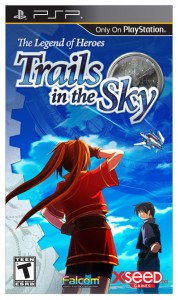 Platform: Playstation Portable
Platform: Playstation PortableDeveloper: Nihon Falcom Corporation
Publisher: XSeed Games
Release Date: March 29, 2011
Back when the PSP was young, earlier games in the Legend of Heroes series were released for it. They looked like drab, boring little games, and it wasn’t until several years later that I bothered with the system. But now, in what we should really think of as coming from beyond the grave, a new Legend of Heroes game quite unlike the others has arrived. For starters this is an XSeed release, and I’ve learned that XSeed doesn’t give us a game if they’re not willing to stand by it and play it themselves. But more than that, just looking at the game reminds me a great deal of Skies of Arcadia, and I know that sort of high-flying, never say die spirit is something I really miss in my RPGs in recent days. Of course, that’s just looking at a box. How fair a judgment can be made from this cover? Read on.
Good: Estelle is downright infectious
Bad: Fairly sudden points of no return
WTF: Need… Second… Chapter…
From the outset, I mention the cover of the game, and it reminding me of Skies of Arcadia. And why wouldn’t it? Pigtailed action girl, lots of open sky, and airships! Surprisingly enough, this isn’t too far off the mark in a lot of ways. While the game is, surprisingly, firmly planted on the ground, the entire game has a very turn of the century feel. There’s a definite blend of swords and other traditional fantasy fare with a society that’s clearly in the middle of technological revolution. Guns have been invented, airships cruise the skies, motor vehicles move freight, but most of all there’s a mineral resource which, in addition to fueling technological advance, also fuels character magic. So in this world where the fantastic and the wonders of the 19th century collide, perhaps it’s fitting that two distinct eras of gaming graphics exist side by side. Hearkening back to the original Playstation, we have 3D effects and vehicles coexisting with character sprites. The artwork itself is recognizable as Falcom’s work, and it uses the sort of character portrait boxes very ‘anime’ games so often sport these days, complete with expressions for every occasion. Oddly, the sprites themselves have relatively few different animations, so there’s a few times it stands out that they’re reusing some, but otherwise you really get what you might expect from the cover.
Falcom has some amazing musicians on staff. The Ys series has some absolutely spectacular pieces, and the best work they put out is quite possibly the best music to come out of a video game. So if I say I was disappointed in Trails’ soundtrack, it is only in that context. There’s not a bad track in this game, and the way it sets mood and creates the atmosphere throughout the game is very precise. Thing is, Trails in the Sky is a very upbeat and relaxed sort of experience, and as such the music made to set that tone can only pack so much in the way of emotion and energy. As such, far and away the standout here is Silver Will, which uses electric violin to achieve the same sort of pulse-pounding tempo as, say, Those Who Fight Further from Final Fantasy VII. It’s quite a ways into the game before it crops up, but suffice to say you’ll know it when you hear it. The vocals are also quality, if you’re into that sort of thing. Trails has some voice acting, but it’s limited to battles, and as such there’s no meaningful commentary to be made beyond the fact it uses established veterans like Johnny Yong Bosch, maintaining a basic level of quality.
http://www.youtube.com/watch?v=7-qrINOufx0
Trails poured all its gameplay into the battle system, so we can focus on that. The system in place is really quite basic, a CTB turn gauge on the left hand side of the screen gives you a basic indication of the flow of battle, but keep in mind that it only displays a single turn for a given character at a time; if someone is going to be lapped, you won’t know it until other characters take their turn. Over time, for most battles in the game, the turn gauge will also show icons, which represent when AT Bonuses are going to kick in. These are fairly straightforward, either healing you in some what, raising your loot after battle, or boosting your attack and critical hit chances. Some strategy elements are in place, with characters having movement and attack ranges, spells having area of effect, moving but not attacking speeding up your next turn, but over time these matter less and less as both you and enemies become more powerful.
Otherwise, characters have two distinct set of resources, EP and CP. EP works as a standard magical resource, being filled when you rest and consumed when you cast spells. CP meanwhile fuels physical techniques, and starts at 0. It fills when you attack or take damage, each varying based on how much you take relative to the maximum HP of the target; oddly, attacking enemies with lots of HP actually gives you more CP than killing them in a single blow. While EP raises based on using the skill system (more in a moment on that), CP is rigged with a maximum of 200. The wrinkle in Trails’ system comes from this, because at 100 SP you can begin using the S-Craft, a sort of Limit Break technique which consume whatever CP you have, and gains a bonus at a full 200. What makes these unique is that, as long as you have the CP to cast it in the first place, you can interrupt the turn order to do so. Late in the game the regular techniques come into their own and compete for the CP, but for a long time you want to sit on CP and be able to pile on damage with a chain of S-Craft interruptions. Even if you don’t strategize that way normally, it makes for a great emergency button to say the least, never mind the times you may want to interrupt the turn in order to capitalize on AT Bonuses.
As noted earlier, the world of Trails is in the midst of technological revolution, brought about by what are called Orbments. Orbal technology fuels nearly everything you see within the game, and that includes magical skills. Each character possess a unique Orbment set, into which they insert Quartz to enhance their abilities. The Quartz themselves come in 7 different elements, and each Quartz has two properties. It will have an overt effect, such as enhancing HP or decreasing casting time on spells, and will also add different levels of their element, though advanced Quartz will add multiple elements at once. Each character’s Orbment contains seven slots, but how those slots branch determines what magic they will actually be able to access. Essentially, the magic levels added by each Quartz are tallied based on what branch of the Orbment they occupy, and every spell in the game has specific requirements of magic levels in order to be accessible in battle. So for example, the schoolgirl Kloe has a single branch on her Orbment, thus all her element levels are tallied together. Meanwhile, the gladiator Zane has five branches, meaning that he can build up very few element levels and is better off equipping Quartz to maximize his stats and fight physically. The added wrinkle here is that most characters have some slots which much be occupied by a specific element, meaning that they will always have some levels in that element and should probably be built around that limitation. It’s a simple system, but offers that blend of character uniqueness and customization that is best for jRPGs.
Trails in the Sky has some of the most extensive background information I’ve ever seen in an RPG (only Ar tonelico has a comparably thick ‘Story’ section in its manual!), so before discussing the plot I should probably provide some of that context and terminology. The setting of the game, and home of all the principle characters, is the Kingdom of Liberl, a small nation between a large northern Empire, Erebonia, and a mid-sized Republic, Calvard, to the east. Ten years prior to the game, Erebonia and Liberl fought what’s called the Hundred Days War, in which all but their capital was taken, but a fierce counterattack opened the door to negotiations, which was overseen by officials from the Church and the Bracer’s Guild. The principle characters of the story are all affiliated with the Bracer’s Guild, an independent agency that blends elements of private investigators and mercenaries, though they are bound to avoid influencing the politic of their host cities to foster their presence in all nations through the continent. Instrumental in all these events and organizations is Cassius Bright, greatest warrior in the land, top member of the Bracer Guild, and father to our heroes Estelle and Joshua.
The story begins with Estelle and her adopted brother Joshua graduating from basic training in the Bracer’s Guild, and becoming junior members. As junior members, their next task is going between the various regions of Liberl to gain the recommendation of each branch, and this serves as the framing device for the story. While the story arc of each regional branch always contains elements building to a larger conclusion, Estelle and Joshua’s overall goal and station are always at the forefront, and their progression through the increasingly dangerous situations plaguing each city they encounter always serve as a marker of their growing skill, determination, and maturity.
What really makes the story work is the bond between Estelle and Joshua. While Estelle has more than a few idiot hero traits and Joshua is very much an enormously competent straight man to most proceedings throughout the game, it becomes clear through the game that neither can truly solve their problems on their own. Each knows the other better than they know themselves, and it’s through this knowledge and the combining of their disparate skills and temperaments that they can achieve anything. But even without that, the game is simply well written, with snappy dialogue and a keen awareness of the tone each scene wants to set. Estelle and Joshua alternate between fighting like brother and sister and bickering like an old married couple, but as they genre savvy among you might guess that’s not far from the truth anyway, and it really brings home the cast, story, and world of Trails.
Trails offers little in the way of bonus content; an optional bonus boss wouldn’t really fit given the context. By which I mean, you have to keep in mind that the Trails in the Sky we have right now is merely the first chapter. But cliffhangers aside, what Trails lacks in aftergame content is makes up for with a robust and systematic series of sidequests. As noted before, the Bracer’s Guild has elements of private investigators and mercenaries, and throughout the game it’s critical to divert from your current missions to complete additional quests for the Guild (lest you want to run out of money and get underlevelled very quickly, of course). These range from hunting down dangerous monsters to finding lost kittens (seriously), and generally speaking each segment of the story offers around 10 such missions, spread throughout various plot markers in that chapter. Beyond this, the game also offers hidden sidequests, jobs you can do but will not show up on the Guild’s quest board, meant to encourage the player to explore on their own rather than running from quest to quest. However, it’s important to note that most quests have time limits, as defined by story progress, so it’s important to check the board as frequently as possible for new quests and to do those before anything else.
What Trails in the Sky offers us is a rare breed, a game built around making a world and putting not only likable characters in it, but making us care about their pasts and futures in addition to their present. To a certain extent it prides itself on putting all the old cliches on clear display, old favorites like the requisite Tournament Arc, but establishing at each step that somehow it makes sense for them to be their. Even without the financial and material gains, I found myself compelled to complete each quest and annoyed early on when I realized I’d missed one or two. With that, I found myself finishing Trails in around 36 hours, and give it my highest recommendation for anyone with the means to pick it up.
Final Score: 8/10 Recommendation: Buy it now!
]]>
——–
SHADOW COMPLEX
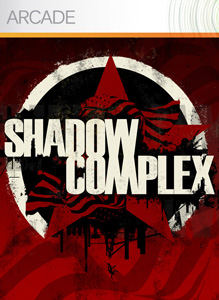
Platform: XBox 360 Exclusive
Price: 1200 MSP[$15 roughly]
Publisher: Epic Games
Developer: Chair
Genre: Metroid-style action exploration platformer
ESRB Rating: M
Players: 1
Shadow Complex is a very important game for the 360’s online service. It was one of the first to really push the limits of what was acceptable to be put onto XBLA, and helped paved the way for a lot of other great titles that got onto the service, several of which I will be reviewing in due time. Its success of over 500’000 units sold helped prove to MS that having large games on the service was not actually a bad thing. But why was it so successful? What could this game offer? Read more to find out.

STORY: The plot of Shadow Complex is not complicated. You play as a man named Jason, off on a hiking trip with his new girlfriend. She runs off ahead when they get there and soon enough, things go south. She gets kidnapped by a mysterious military force, and Jason decides to rescue her and unravel a crazy government conspiracy in the process. It’s honestly a pretty minimal game on plot however, there are some cutscenes but most of the exposition and setup of the story is in the background, heard by grunts that don’t notice your presence. It’s nothing really original, but it doesn’t do anything particularly horrible either. Not really why you play the game though. And for those concerned about plot in your Metroids, there is cutscene skip.
GAMEPLAY: This game is Super Metroid. Well, okay, that’s simplifying things a lot and there are differences, but this game is a big homage to classic Metroid games in general. This is an exploration based platformer where you navigate a large 2D area, collecting powerups and fighting through hordes of enemies. There are some notable differences compared to Super Metroid however. For starters, the controls. As this game uses the XBox 360 pad and not a SNES pad, the controls are actually a bit less cluttered than Super Metroid’s were. You can use the right analog stick to aim, and you have two different fire buttons. RT shoots your main gun and RB shoots your alternate weapon, like grenades and foam. These additions help the controls feel nice and smooth, even if you have to use the terrible 360 DPad to switch weapons.

One of the notable differences is its usage of the third dimension. While the game is in 2D, enemies attack from the foreground. Fortunately, the game tends to auto-aim well enough to deal with them as long as you aim in their general direction when attacking. On top of that, there are some bosses that utilize the foreground and a couple of parts where you take control of a turret and fire into the foreground directly. While it doesn’t change the gameplay THAT much, it’s still definitely there and worthy of noting.
Another major difference is how the game handles inspecting nooks and crannies. Anyone who has played old Metroid games know how it is, you curl up into a morph ball and bomb everything in sight and see what things pop up on the tiles as a result. In Shadow Complex they took a simpler approach, Jason has a flashlight you can turn on. Aside from helping explore dark areas, it also makes certain objects light up, letting you know if they can destroyed and, if they can, how to destroy them via simple color coding. This helps speed the gameplay up compared to Super Metroid, as you don’t have to spend as much time investigating areas to figure out what can be destroyed and what can’t.

But don’t let that fool you into thinking finding all items is easy. On the contrary, full 100% completion in this game can be quite challenging, with some very cleverly hidden items. One of the little flaws with the game unfortunately, is that there’s an event that triggers right before the final boss in the game and that can trip you up. It triggers an explosion event that can potentially screw you out of one the upgrades permanently, albeit one that is not needed to finish the game. But more distressingly, the entire eastern part of the map becomes unavailable because the final boss is unavoidably in your way after that event. Aside from THAT, the game is fairly open about how you can explore it, and also like Super Metroid beatable with bare minimum upgrades. It’s entirely possible to beat the game with 13% items collected, there’s even an achievement for it.
But aside from going for 100%, this game has plenty of content that many different strokes of gamers can enjoy, from the speedrunner to the completionist to even the casual player. Multiple difficulty settings, a special challenge trial mode, and it even contains in-game achievements that aren’t a part of the normal achievement system. As long as you don’t mind your game being a little non-linear, it’s hard not to like this game.
GRAPHICS: While the art direction isn’t the most amazing thing you’ll see in games, the level of detail in the backgrounds is pretty good overall, though it can be kind of hard to notice when in the middle of a firefight or looking for items intently. It’s low on the browns and greys of your typical Unreal Engine 3 game, which certainly helps. There’s prettier games, but this game does the graphics alright enough overall.

AUDIO: Probably the weakest part of the game here. There’s barely a soundtrack at all, and none of the tracks really stick out at all. The voice acting is alright, there’s much worse out there but it won’t exactly rivet you with powerful dialogue. The sound effects are fine and all fit with whatever they are associated with, and for the most part your treks through the mysterious complex are silent aside from explosions and gunfire.
In short, Shadow Complex is a very gameplay-oriented game. The story is kinda generic, the graphics aren’t especially amazing, the sound design is weak as hell, but the gameplay is one of the strongest examples of a classic Metroid title in a long time. In an era where Nintendo and Konami are both rather afraid of sticking to their guns in their Metroidvania titles, this game stands against that and celebrates those games. It has some small problems, like the aforementioned dickery against completionists, but is overall a game that is definitely worth giving a try. Unless you really hate games that are styled after Metroid, I’d recommend at least giving it a try. It has enough content to be worth $15 at the least.
]]>This brings me to today’s subject, the Chrono Series. When I considered my next project, people immediately recommended Chrono Cross, because “you can talk about CC at the drop of a hat anyway”. Which is probably a fair point, but I don’t think the failings of Chrono Cross at the writing level mean much without talking about Chrono Trigger. But in considering CT as its own article, I was unsure the game was actually written to have strong central themes. So in what follows, I’m not entirely sure if I’m stretching in order to strengthen my point later or seeing a legitimate aspect of Chrono Trigger’s story, but I think you’ll agree it makes a lot of sense and fits with what’s in the game.
The Chrono series, taken as one game following logically from the other, shares one primary trait; strong environmentalist overtones. Seriously, look at Chrono Cross; the cast is new, the setting is a tiny subset of the world we later learn didn’t EXIST until after Chrono Trigger’s plot resolved, the storyline until very, very late could be easily mistaken as completely unrelated, the mechanics of magic are entirely different, and the central plot gimmick has shifted from time warps to cross-dimensional rips. Hell, they entirely changed the gameplay and the artist of Chrono Cross isn’t even trying to put his work in line with Akira Toriyama. So at this stage in the discussion, you should be ready when I say that even the thing these two games have in common are done very differently.
See, the aforementioned environmentalist overtones directly influence the overall themes of both works, but each has a drastically different message to take away from it. We start with Chrono Trigger, since we want to establish firmly the mindset Chrono Cross was meant to be a sequel to. In as much as Chrono Trigger is about anything, it’s really about self-determinism (to use the term colloquially. There’s some psychology-specific uses that aren’t entirely accurate here). You get this a lot in time travel stories, but the simple notion that there’s no such thing as Destiny, that the free will of intelligent beings shape the future, is essential to Chrono Trigger. A freak accident might send them spiraling through time, but from there everything that happens happens because someone chose to do it. Marle’s uncanny resemblance to Leene erases her from history, Crono saves Leene to put history back on course. Crono is imprisoned unjustly, he breaks out (or Lucca stages a jailbreak, doesn’t change the basic premise). And the big one. The trio find themselves in a grim future. They press forward, determined to understand where and when they are. They see the dismal remnants of the human race, and do all in their power to help them. They seek as much information as they can on the calamity that befell the world. They find their answer; well beyond their own lifetimes, an evil so ancient and powerful they can hardly understand it rains untold destruction upon all life. And three teenagers refuse to accept this. The world doesn’t deserve such a fate, and they know that no doom is written in stone. History CAN be changed, and they WILL do it.
It’s simple, it’s powerful, it’s perhaps the cornerstone of what makes Chrono Trigger and it’s cast so beloved. Naturally, the rest of the cast follows a similar arc. Frog starts the game rather mopey, feeling himself a failure for not saving Leene, letting Cyrus die, and so forth. The turning point comes when, seeing the reforged Masamune, he decides to grab hold of his destiny and face Magus in his keep. Robo takes this to levels TV Tropes would call being a Determinator; reprogrammed deep within the Mother Brain’s factory, he rejects his ‘default’ identity entirely to remain loyal to the party.
The remaining party members already show strong traits of the self-determinism theme. Ayla from the outset acknowledges she’ll have to lead her people to war with the Reptites. Magus has dedicated YEARS to summoning and defeating Lavos, avenging his sister. It’s more important to note here that both, while strong and determined, still only find success in their missions once they join the party. This is where the idea of choosing your own destiny ties back into the overriding environmentalist concepts. In addition to an overtly environmental set piece, the reforestation of the desert sidquest, at heart the entire plot has a clearly environmental subtext. Everything in the game ultimately comes back to Lavos. But what is Lavos? Well, he’s a space-faring monstrous thing which feeds on life force at a planetary scale, who crashed into the planet some 65 million years ago. Ultimately, after his landing, Lavos is at the heart of the conflict in every era. His corruptive influence poisons Queen Zeal, triggering the fall of the magic civilization. Consumed by vengeance, Magus builds his armies and attempts to defeat him in 600 AD. 1000 AD, as we learn, is basically idyllic. He personally destroys all civilization in 1999. By 2300, Lavos’ spawn feast off the pitiful remains of the planet’s energy, while his very presence sends the surviving machines to genocidal heights.
So let’s ask again. What is Lavos? Corruption. It saps the very life of the planet. It influences all living things, stealing what evolutionary traits aid it, to further its ends. At the height of human civilization, the Kingdom of Zeal inexplicably decided to switch from the slow, steady power of the Sun to the raw magical might of Lavos. Soon the entire civilization became devoted to exploiting more and more of Lavos’ power, culminating in the Ocean Palace disaster. Lavos’ very existence killed off an entire race of intelligent dinosaurs. In short, Lavos is a sort of shorthand for technology and greed running massively out of control, destroying everything in its wake except the handful so amoral and corrupt they see it as beautiful, such as Queen Zeal in the time we know her. And before that sounds too preachy, just keep in mind that the party uses magic too, and magic as it exists in Chrono Trigger descends from the post-Lavos Zeal Kingdom. Nevermind the presence of Lucca and her inventions which enabled the adventure to go anywhere at nearly every turn. It’s not technology unto itself which they fight, but the cancerous, out of control greed of it. And going back to Ayla and Magus, it’s something they have to accomplish together. Each individual, their mind firmly set on their goals, has to choose to work together to defeat the embodiment of technology gone wrong. We choose to make the world a better place, and we can only succeed when we work together. Not deep, but powerful, and fitting for the crown jewel of 16-bit gaming.
Chrono Cross meanwhile is complex. Well, that’s not entirely accurate. Chrono Cross is written with many branching plots and shifts in tone and direction, as well as containing some of the twistiest plotting in RPGs. I mean, this is the game where the primary antagonist steals your body midway through the game and you’re stuck as a cat-man for roughly half the game’s running time because of it. But in taking everything I know about the plot and trying to boil it down to the central theme… well, I kept coming back to this.
And that’s not entirely fair, but neither is is inaccurate. While a few key set pieces in Chrono Cross really do cross into MAN! territory, in particular every single permutation of the Hydra Swamp and the Dwarf migration that results from it, a good chunk of the game really has nothing to do with nature or the fundamental failure to respect it embodied in human-kind. But that majority portion of the plot deals, and this is actually mind-blowing if you were playing the game and didn’t know how it ended, with being the sequel to Chrono Trigger. Yet somehow, even that really ends up being a diatribe on the failures of humans.
But I’m getting ahead of myself. Skipping some parts here and there, because Chrono Cross has an absurd plot when you start trying to analyze it and I want to retain some semblance of focus, let’s walk through the basic plot arc. We’ll make some slight detours along the way for MAN!, of course. We’ll start after the opening Dream Sequence. Serge wakes up and is more or less immediately harassed into getting a necklace for his girlfriend. Naturally this involves hunting down and slaughtering young lizards until their mother shows up when the genocide finally make her pick up and notice. On the beach, Serge’s girlfriend shows up, and has an extended monologue to the effect that everyone makes decisions each day that determine their fate, and looking back on the past, and the decisions they made to reach where they are now, is how everyone will spend their futures. So… once you decide something, or do something, the consequences of it stay with you forever. It’s pretty early in the game, yet we’ve established a massively different mindset from Chrono Trigger.
At this point Serge is sucked into another world. In this world, he is dead, drowned as a child. We’ll come back to this later. Ultimately Serge is railroaded, one way or another, into helping a perky stranger named Kid into invading Viper’s Manor, base of the local lord. It ends badly, Kid is horribly poisoned by her nemesis, Lynx. This leads to the first branching point, whether or not to save her. If you save her, you go to the Hydra Swamp, kill everything within, and destroy the environment. If you don’t, you skip ahead to the next plot arc, Kid lucks out massively and someone with the cure wanders by, and hunters do all the killing for you off screen. In either case, there’s multiple detours here, many of them optional. The one that isn’t is… fighting a ship full of ghost pirates. Aside from setting up Fargo’s character arc, which will be more important later, I really don’t get this. Actually, I do, but that’s really something to save for a review of Chrono Cross. An optional quest worth mentioning here is the Water Dragon Isle. You have to walk through a volcano to progress the plot, and figure the Water Dragon might have something for the whole air temperature over 1000 degrees issue. Sorry, I meant the walking on lava issue. Silly me. Anyway, when you arrive, the Dwarves of the Hydra Swamp have invaded the native Fairies in search of a new homeland. And by invaded, I mean genocide. After fighting off their mobile siege tank, and by all evidence killing off the Dwarven race, you get the blessing of the Water Dragon. Hurray! Also the sole surviving Fairy (unless you saved Kid and recruited another one) screeches at you to get off the island, you horrible murderous MAN! Not, y’know, person who saved my life from the dwarves, but “I totally believe everything the people who wiped out my race said and DEATH TO ALL HUMANS”.
Detour and trek through lavaly lavanous lava later, we advance the plot in Ft. Dragonia. Now, this is the point in the game at which you switch from Serge to Lynx but ultimately? Nothing about that is actually relevant at this stage. Sure, there’s a reason Lynx needed Serge’s body, and obviously the fact that you’re a furry supervillain affects how the plot progresses, but we’re going to let that sit for now and jump ahead. Apparently, gaining Serge’s body gives Lynx the power of Dread Lord Cthulhu, and Serge is banished to a dark dimension. Here, since he already has no idea what’s going on, Harle gives him an extended monologue on his situation. She explains that, because he is now in Lynx’s body, Serge is in fact Lynx. Perception is reality, and to reject reality is beyond a meager spirit like Serge. Following his rather fatalistic conclusion that was probably also a proposition, Serge and Harle make their way back to the real world via an Escher painting populated by Paper Mario rejects. Now, for the next bit of the game, we’re on Serge’s Home World, where the vast majority of the previous section was in Another World. The Home World is rather dystopian in its way, with most places under control of the Porre military, complete with guards on every street corner, the demihumans of Marbule live under borderline slave labor conditions aboard Fargo’s pirate ship, and so forth. Serge discovers that, because he’s not Serge anymore, he can no longer cross between dimensions, so he’ll need to figure out how to fix that in order to chase down Lynx. Just roll with it.
After recruiting his village elder using his pure, innocent Serge eyes which clearly don’t belong to feline supervillains (though I suppose travelling around with a Harley Quinn expy would make anyone look like more of a supervillain), our crew discovers they should totally seek help from the elder of Marbule. Now, the Elder basically mops the floors on Fargo’s ship, and he’s rather bitter about the whole human race. Though at least this is less MAN! and more “Fargo is a dillhole and it’s made me angry about my lot in life”. They fight a bit, afterwards Serge’s incorruptible pure pureness convinces him to send them towards the Dead Sea which somehow will weaken the barriers between dimensions… um, sure, let’s move on. In the entrance to this fabled place, we see… the Masamune! Holy crap, an unambiguous connection between this game and Chrono Trigger! Or was that confused? the Masamune radiated pure evil that could kill people with its sheer evilness in Chrono Trigger, right? Maybe someone slipped some of these plot points in as a metaphor for Chrono Cross in general. Anyway, Elder Radius claims we’ll need the Einlanzer, some sort of draconic holy blades, to counter the Masamune’s deadly radioactive evil. Thus we go to the Isle of the Damned, and seek out the grave of Garai, Radius’ badass partner and father of several characters I haven’t mentioned yet. Turns out, Radius actually kinda straight up stabbed Garai in the back under the influence of Masamune’s emo rays, so Garai has become an angry holy spirit of vengeance who will murder anyone in Radius’ general vicinity. You win, presumably condemning him to eternal damnation due to being a supervillain, and use the Einlanzer to banish the Masamune. Woo hoo! Let’s go to the Dead Sea!
Now, the Dead Sea is where Chrono Cross actually takes the time and establishes itself as a sequel to Chrono Trigger. The way it does this, while explained in the game, isn’t done in a very coherent way. The essence of it is that, the way the series uses time travel, there are a relatively limited number of ‘true’ timelines. In fact, a large part of Chrono Cross’ endgame involves the idea that you need to merge the various dimensions seen throughout the game into a harmonious timeline. Now, in the natural order of things, when an existing timeline is averted due to time travel altering the future, it is not merely erased, but displaced by the emerging timeline. The timeline which no longer exists (to use a relevant example, the Lavos-devestated 2300 AD seen in Chrono Trigger), it’s displaced to a sort of temporal graveyard referred to as “The Darkness Beyond Time”. It would similarly be where Marle was sent when she negated her own lineage in Chrono Trigger. So while it’s still ‘there’ in some sense, the displaced time no longer has real substance or definition.
The Dead Sea is basically a case where aspects of that un-existence crossed over with a legitimate timeline and left bits and pieces of deleted history in the material world. As such, lots of different areas, mashed together rather nightmarishly, comprise this very large dungeon. While bits of it actually are the aforementioned 2300 AD from Chrono Trigger, allowing us to see the deserted highways of that timeline, as well as an unambiguous connection to Chrono Trigger in the form of the computer terminal which originally told Crono, Lucca, and Marle about Lavos’ rise and his destruction of the world, other bits are mixed in as well. A relatively modern mall makes up a large piece of it, and in the end we see Nadia’s Bell, christened during Chrono Triggers best endings. The implication, and later outright statement as we’ll see in a moment, is that somehow the future arising from Lavos’ defeat in Chrono Trigger was also erased. How? Apparently Serge did it. How? He caused the Time Crash! What’s that? I have no fucking idea. It’s a dropped plot point. It never makes any goddamned sense. Apparently, the fall of Guardia was triggered by time travel, but nothing in Chrono Cross explains that this happened or how the supposed Time Crash did it. In fact, it makes so little sense that the DS release of Chrono Trigger just implied that Dalton, our favorite comic relief villain, did it. Maybe the Time Crash let him out of the Darkness Beyond Time? Fuck if I know. Anyway, let’s watch, and we’ll get our lead-in to more logical parts of the game.
http://www.youtube.com/watch?v=5x-M1xaFYSU&feature=related
If you watched the whole thing, you also saw Miguel’s big speech, in all its fatalistic glory. This of course is partly to set up the next phase of the game, FATE the evil computer, but it also has some similarities to Leena’s speech way back at the start of the game. Probably not coincidental that Leena is Miguel’s daughter. Able to cross dimensions once again, you make a brief detour to help out the Dragoons, then settle into tracking down and enlisting the aid of the six dragon gods. This basically boils down to a series of non-linear side quest that you happen to have to complete. The only one really worthy of note is awakening the Black Dragon, which actually involves completing (unless you fucked it up earlier) the Marbule quest discussed back when you had to track down the Sage thereof. Basically, you blast the shoreline with the power of rock to materialize monsters, then kick ass. So wait. We’re actually averting natural disasters now? We’re doing the direct opposite of MAN!? Holy hell.
But more interesting than any of this, about this time is when the Masamune sidequest opens. I haven’t been talking about them, but the Acacia Dragoons are pretty much the only cast members with dedicated plot outside the nonsense passing as the main narrative. The gist is that the greatest among them, Dario, was lost at sea. As it turns out, he and Karsh, the most active among them, discovered the Masamune on the Isle of the Damned. Dario became possessed by it’s evilly evil evilness, and Karsh was forced to strike him down. But thanks to one of those Schrodinger’s plot devices, in the less FATE-controlled Home World, Dario actually survived this trip, washing up on a tiny island. When you work all this out and try to restore his memory, however, the Masamune shows up and boss fight! Serge’s awesomeness, however, purges the blade of its evil once you win, causing Masa and Mune to start talking. They’re joined by their sister Doreen and join up with Serge’s weapon, forming the Mastermune. Here’s the thing, though. The implication is that, for whatever reason, the spritely dream spirits which gave the Masamune it’s power were completely dormant for a long period of time, quite possibly since the conclusion of Chrono Trigger some 20 years prior in in-universe time. So… because the sword was just a weapon… why was it pure evil again? It was just made of a rare rock, Dreamstone. That certainly wasn’t inherently evil. Meaning… because the good dream spirits weren’t active, the blade took on some other emotions? I mean, it’s a bit of a leap but the only reasoning I can think of here is that, without Masa and Mune, the sword took on the spirits of its wielders. In turn meaning that… humans are pure evil. Ha! Thought you could sneak a MAN! past me did you game!? A pox on that.
With all the dragons awake, apparently it’s time for Serge to get his body back. This basically involves going to Ft. Dragonia and using the shattered remains of two different magical crystals to do the job. Seeing as just one of them did the body swap in the first place, this makes at least slightly more sense than several other plot twists. But rather than stealing his body back or something, Serge is actually treated to a brief history of the world. Keep in mind, this is a fort built by dragon-folk, who are basically to CT’s Reptites what modern man is to cave men, so there’s a different perspective at work. Anyway, they essentially exposit about Lavos’ landing 65 million years ago, and how his presense, and that of the Frozen Flame, directly accelerated human evolution, leading them towards being dangerous tool users who wiped out the dinosaurs and are a grave threat to the planet itself. And then Serge is sucked into the reformed crystal, reduced to a fetus, and rapid aged back into his 17 year old body. Naked. Faaaannnservice~
At this point it’s time to fight FATE. We’re given rather a large info dump here. FATE is the sentient computer governing things at Chronopolis, a human city from the year 2400 AD. In essence, it represents the culmination of the future written in Chrono Trigger, human civilization advanced without the catastrophic rise of Lavos in 1999. Because this future was not a desolate wasteland, when the Zeal Guru Balthazar arrived in 2300 AD, he found a functioning society and as such his experiments were greatly enhanced… right up until the point an experiment sent the entire city thousands of years into the past. This, apparently, is that whole Time Crash thing. I’m not sure what that has to do with Serge. Being so far into the past, FATE used its extensive history archives to try and ensure its own future came to pass, sealing off the El Nido islands to keep itself hidden and manipulating people into making the ‘right’ decision. Anyway, Chronopolis was apparently deemed a deadly threat to the very planet, so it retaliated by dragging a similarly advanced dragonian city back through time to do battle with the humans. The humans, who had control of the Frozen Flame, won anyway, and separated the dragonian super advanced computer into constituent parts, the… dragons we awakened earlier. Well, that won’t come back to bite us. Anyway, when Serge was injured as a toddler, his father stumbled onto Chronopolis and Serge became registered as the Arbiter of Time, and gained sole access to the Frozen Flame. Sooo FATE really needed that back to do the whole governing humanity, plus of course Serge existing was causing a major dimensional rift which negated FATE’s ability to control events in the Home world. Which means… that the world where the egomaniacal computer controls people is pretty well off, while the one it’s mostly locked out of became a bit of a dystopian hellhole. I’ll come back to that. Anyway, FATE’s a bit loopy at this point, so we fight to the death and win. At which point the dragons attack and steal the Frozen Flame. Damn.
At this stage in the game, Kid has gone catatonic. Since we need to kill some time before going off to the final dungeon, we decide to help! Apparently, her catatonic state is actually caused by a temporal paradox masquerading as trauma, because we have to time travel back to when her orphanage was burned down and save her to wake her up. Yay, honest to god time travel in a Chrono game! We could wait a bit and use the Mastermune and a portable black hole to do this, but we’re actually supposed to use the game’s central plot device, the Chrono Cross. It apparently has the power to mind meld you and break rules of temporal fixation. Neat. Anyway, it’s behind a waterfall the game admits exists exactly once prior to this. Because Chrono Cross really wanted you to get a non-ending and not know a fucking thing that happened, as though trying to hide how sloppy the writing was. Anyway, time travel, save Kid, good stuff. The important thing for this article is what happens after. Once Kid’s woken up, you can retrieve a letter left for her by Lucca, as in Lucca the Great, mistress of space and time and an actual, non-stupid Chrono Trigger reference… or so we think. Actually, her letter basically talks about the implications of displaced timelines, and how Lucca was convinced that eventually someone from deleted time, or perhaps someone from a more depressing part of the timeline she created, would travel back and take revenge on her. I hate this game sometimes. Yes, surely some point in the future would be worse than “The entire planet was eaten by a lovecraftian nightmare and the burned out husk was ruled by insane robots who systematically wipe out everything left”.
Final dungeon. It flies. You beat up an amalgamated dragon god. That’s not the interesting part, although there’s more than a little MAN! content scattered around. No, the stuff we want is in a room right before then, when we meet up with Balthazar. Turns out, he was the wizard who did it! Seriously, the game makes this claim. Everything, from Lynx stealing your body, your near-drowning splitting the dimensions, Porre’s invasion, the struggle between FATE and the Dragons thousands of years ago, all of that? Balthazar. How? Oh god don’t ask that. Why? Well he tells you that! He needs you, Serge, to be able to get the Chrono Cross. Because Serge, and only Serge, can use it, and he needs it to defeat the real villain… Schala! Okay, so technically, Schala partially merged with either Lavos or a spawn, and the actual goal is to use the Chrono Cross’ mind meld powers to harmonize the universe and shatter the connection between her and Lavos-ish influence, saving her and getting rid of a being that apparently can destroy all space and time simultaneously. So moving forward again, we defeat the dragon god, then go back to the beach where everything started. We see the Chrono Trigger ghosts again, where they make stupid revelations for the sake of it. I chose to ignore that for now and go to the final boss fight, wherein you have to use every element in a specific order to play the game’s theme song and thusly defeat the villain. And then Schala monologues for a bit on the value of individual life and impregnating planets, and announced that we got the Ocarina of Time ending! Yep, the dimensions remerge, nothing in the game except freeing Schala ‘actually’ happens, and Serge gets to live his live as a normal person. I’m so tired suddenly.
So, know what the theme is? I don’t blame you. But the running constant here is consequences. Humans take action, and the repercussions ripple out forever and a day. All the MAN! stuff is, obviously, humans. The convoluted plot with FATE and the Dragons? Balthazar. The semi-dystopian Home world? Without FATE controlling people, human actions lead one into another until it was a military dictatorship. The entire plot of Chrono Trigger? Consequences so dire that it threatened TIME ITSELF. More than one character espouses outright fatalism, yet always it is emphasized that you take action, and the consequences go on forever. I know it seems kinda weak, but the plot is so muddled that there’s really little more to take away from it. A big production that goes on for hours and says next to nothing.
But let’s go way back. This is the sequel to Chrono Trigger, a game about self-determinism, cutting a path through history to write your own fate. Chrono Cross, we come away with the idea that… everything people do have consequences, and because humans themselves are evil, those consequences are similarly always evil. I just… don’t even know how you get between those two ideas. I know that, in the very end, Chrono Cross tried to show human action having positive effects, and Schala espouses the idea that all life can have a positive impact on the world, but so much time is spent showing how evil people are… it rings wholly false. In the end, we have two thoughts.
Chrono Trigger tells us that we have to make the world a better place.
Chrono Cross tells us that everything we ever do will ruin something, and nothing we can do will ever make up for it.
You tell me which one will be fondly remembered in 20 years.
]]>Lots of people in our community have been obtaining 360s and PS3s as of late, and I still see remarks from various people about how there are few games that are any good on the platforms. I feel that this is not an accurate statement, and above all ignores a prominent sector of both console’s libraries: the digital distribution network. There are actually a pretty decent number of good games on both XBLA and PSN, which are easy to overlook if you’re not intimately familiar with both services. This review column was an idea I had to help alleviate this problem, to shed light on notable games on the service and hopefully convince people of what these services have to offer. I plan on updating this column once every two weeks, so that I can have time to ensure the individual reviews will be of quality.
Without further ado, here is the first review. This game I believe represents what both services are capable of, and that game is Pac-Man Championship Edition DX.
——————-
PAC-MAN CHAMPIONSHIP EDITION DX
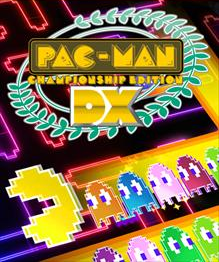
Platforms: XBLA and PSN
Price: 800 MSP/$9.99
Genre: Pac-Man, high speed ghost eating and survival action.
Pac-Man. Everyone’s played Pac-Man at some point or another, so everyone knows how the game plays. You navigate a maze, eat pellets, avoid ghosts, and occasionally eat ghosts. The formula itself hasn’t changed in this game, but how it’s been presented has, through the usage of lots of game modes, high speed tension, and situations that might remind the player of hardcore shoot’em’up titles.

Story: What’s that? This game has no plot at all, but it’s Pac-Man. Nobody really expects for something like that, or cares.
Gameplay: The meat of the game. While the basics of Pac-Man are still there, the way it is presented to the player is very little like the original game. The most important changes come from the original Pac-Man Championship Edition, where they made it so that you would eat pellets until fruit appears, and then collect the fruit to make more pellets appear. Very unlike the original, you now stay on a stage for as long as you can, or until the timer goes down or you meet your challenge goal etc;.
But new to DX are some important changes. For starters, there are more than four ghosts now. In fact, there’s a lot more. New are the “Sleeping” ghosts in mazes, which stand still until Pac-Man passes by them. They will then proceed to follow Pac-Man with utmost precision until they catch him. This brings a risk/reward aspect to the game. You can try to avoid waking up ghosts whenever possible and have an easier time navigating, or you can be a daredevil and try to snake in 50 ghosts and eat them all at once when you get a power pellet for huge score. On top of that, the more ghosts you eat, the faster the game becomes, though it depends on your difficulty what the speed cap is. The starting speed level and cap depends on the stage as well. For example, on the basic Championship II stage, Easy has you start at Speed Level 1 with a cap of 30, whereas Normal starts at 10 with a cap of 40, and Expert starts at 20 with a cap of 50, though do note that some game modes have a fixed difficulty setting. These individual levels actually mean a fair amount, and Expert mode can be pretty insanely fast if you gobble enough ghosts. On top of this, after you spend enough time in a stage, the normal 4 ghosts everyone remembers start appearing in the stage, meaning you have to dodge the homing sleeper ghosts as well as paying attention to the other normal ones in the maze, which can make for very exhilarating moments.

“But wait, Xer, wouldn’t that make this game entirely too possible to screw you with bad luck?”
Well fortunately, the developers thought that too and added two entirely new game mechanics to Pac-Man to counterbalance this. One is slowdown. When Pac-Man gets close to a ghost without a power pellet, the game zooms in and slows down, giving the player time to react and steer out of trouble. It’s not always get out of jail free, but it does help a lot. The other is the addition of Bombs. Yes, like those silly shoot’em’ups where you can instantly vanish all bullets on the screen instantly at a cost. If you use a bomb, all ghosts get reset to the ghost spawning gate and begin chasing after you again shortly after, not entirely unlike shot-clearing in a shmup. These two additions, combined with the much faster pace, make for a very odd blend of Pac-Man and shmup mechanics that is equally strange and unique.

As for game modes, this game has a few. Score Attack is the most notable one, as its goal is to rack up as much score as possible within a certain time limit. There’s also ghost eating challenges[eat x number of ghosts in a row], survival challenges, and a few other modes to sink into. There are 7 stages in this game, plus one from the original Championship Edition, as well as a Free Mode and a Darkness Mode that adds fog of war to any of the existing stages. There’s also a pretty comprehensive online leaderboard, bringing back a little of that score-based competititon between other players, if you’re into that sort of thing.
Graphics: For a game with simple graphics like Pac-Man, this game is pretty. Very colorful graphics, the visual effects add a good amount of flair without being intrusive on the player’s ability to tell what’s going on, and to top it off there’s actually a lot of graphical filter options you can choose when selecting a stage, changing how Pac-Man, the ghosts, and even the stages look, letting the player decide what they think is prettiest.
Audio: The audio in this game is okay. It’s mostly background filler music with a techno vibe, but it does a good job of fitting the atmosphere of the game. The songs tend to have a sort of rush feeling, one that goes together well with how fast the action can move in the game. The actual sound effects and the like are mostly an updated version of the original sound effects, recognizable but at the same time different.
Who would I recommend this game to? People who like really fast action in their games, as well as the shoot’em’up fans in the group. You know who you are. My personal opinion is that this is a fantastic game that’s very much worth the ten dollars, but it may not be for everyone if you prefer your games to be a bit slower paced and not as nerve wracking.
]]>